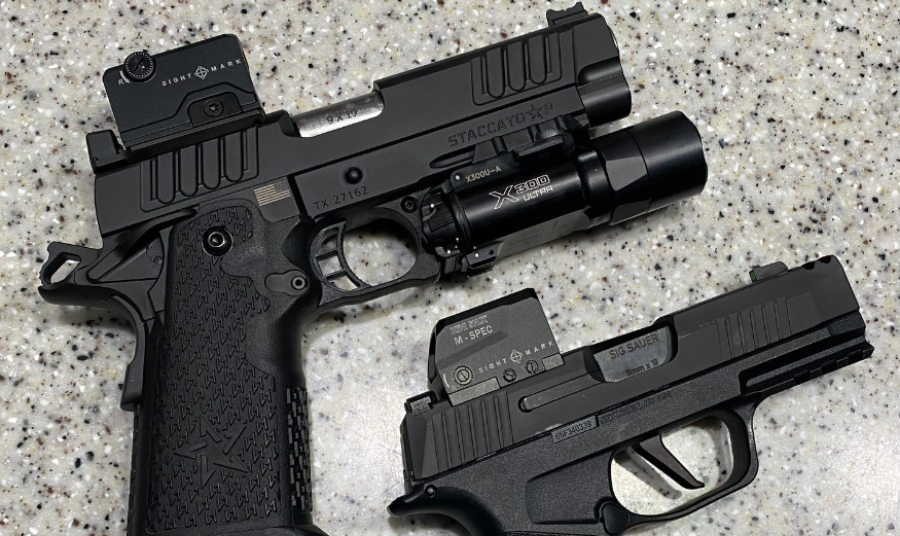The debate between 9mm and .45 ACP has been raging in both law enforcement and civilian circles for decades, and it’s not showing any signs of slowing down. From stopping power to recoil management, caliber choice remains a hot topic, often sparking passionate discussions among shooters.
Let’s start by addressing the elephant in the room: stopping power. Many enthusiasts believe that bigger is always better, but the reality isn’t so straightforward. The concept of stopping power is largely subjective; there is no magic bullet that guarantees incapacitation with a single hit, regardless of caliber (Yes, that includes .50 BMG – USMC Cpl. Jared Foster survived a negligent discharge from an M2 Browning). The cavity expansion generated by a bullet’s impact plays a significant role in incapacitation, but even here, factors like shot placement and bullet design are often more critical than caliber alone.

The .45 ACP and the 9mm have been pitted against each other since the World Wars, when the American 1911 in .45 ACP saw action against users of the P08 Luger chambered in 9mm.
Proponents of the .45 ACP argue that its larger diameter and heavier bullet create a bigger wound channel, increasing the chances of hitting vital organs and causing rapid blood loss. Indeed, a .45 ACP’s 230-grain bullet typically moves at around 900 feet per second, delivering a hefty punch that’s hard to ignore. In contrast, the 9mm’s faster 1200 feet per second velocity with a 115 to 147-grain bullet relies more on speed than sheer mass to get the job done.
So, which one’s better? The answer is, it depends. If you’re banking on raw power and larger cavitation, the .45 ACP has an edge. But when it comes to practical application, factors like recoil, accuracy, and ammunition capacity often tip the scales in favor of the 9mm.
9mm: Availability, Recoil, and Capacity
In today’s self-defense landscape, the 9mm seems to reign supreme. It’s widely favored for its availability, gentle recoil, affordability, and higher magazine capacity. These factors combine to make it an excellent choice for both new and experienced shooters alike. The lower recoil of the 9mm allows for quicker follow-up shots and increased accuracy, particularly under stress. This makes it an appealing option not just for civilians, but also for law enforcement agencies that prioritize hitting the target over pure firepower.
From a statistical standpoint, the market clearly favors the 9mm. There are significantly more firearms available in this caliber, from compact carry pistols to full-sized duty guns. It’s no coincidence that newer pistol models frequently debut in 9mm; manufacturers are simply responding to demand.
Moreover, with advances in bullet technology, the performance gap between 9mm and larger calibers like the .45 ACP has narrowed considerably. Modern 9mm self-defense ammunition is capable of achieving impressive expansion and penetration, making it more than adequate for defensive purposes.
.45 ACP: Power and Suppression
While the 9mm has gained traction, the .45 ACP hasn’t faded into obscurity. Its advocates still swear by its ability to deliver raw stopping power. The round that “won two world wars” still has a substantial presence in the gun sphere, and when it hits, it hits hard. For those who prefer a sense of confidence from the sheer size of the bullet, the .45 ACP’s larger diameter and heavier mass are hard to overlook.
Another point in the .45’s favor is its performance in suppressed firearms. Given its slower velocity, typically subsonic, the .45 ACP pairs well with suppressors, reducing noise without the need for the specialized subsonic ammunition that 9mm suppressed firearms usually use. This makes it an excellent choice for anyone looking to shoot quietly, whether for tactical purposes or just for fun.
Lessons from Law Enforcement
Historically, law enforcement agencies have oscillated between these two calibers based on real-world needs and evolving priorities. In the late 1960s, the LAPD and LA County Sheriffs adopted the 9mm in the S&W Model 39, hoping that its higher capacity would offer an advantage over the traditional 6-shot revolvers of the time. However, this experiment met with mixed results, as the 9mm rounds failed to consistently provide the stopping power needed in high-stakes encounters.
Departments in New Hampshire and Massachusetts also reported incidents where officers had to shoot multiple times with 9mm rounds to subdue suspects, which led to a shift toward the .45 ACP for its perceived superiority in stopping threats. However, as time progressed, advancements in 9mm ammunition, combined with the advent of double-stack magazines offering significantly higher capacities, prompted a swing back towards the 9mm.
Today, many agencies have standardized the 9mm once again, balancing capacity, control, and performance in a package that suits modern policing needs. After all, a modern Glock 17 holds 17 rounds with the option for more—more than twice the magazine capacity as the early Model 39s, which could only hold 8. This shift reflects a broader trend in the shooting community: recognizing that the caliber debate is less about size and more about what you can effectively control and shoot accurately, as well as how many rounds you can send downrange without reloading.
Accuracy, Red Dots, and Bore Sights: The Modern Edge
Beyond caliber, the discussion around handguns also involves accessories like red dots and bore sights, which can significantly impact accuracy. Red dot sights are becoming increasingly popular for both defensive and competitive shooting. They provide a clear aiming point and can help shooters maintain target focus, which is particularly beneficial in high-stress situations.
For both 9mm and .45 ACP, a red dot sight can help mitigate some of the recoil effects and improve shot placement. While the 9mm’s lighter recoil generally makes it easier to stay on target, the .45 ACP’s added punch can still be tamed with practice and the right setup.
Bore sights, on the other hand, are invaluable tools for zeroing your red dot or iron sights with minimal ammunition waste. They allow you to align your sighting system quickly and efficiently, giving you a head start before you even hit the range.
Ultimately, whether you choose a 9mm or .45 ACP, it’s essential to focus on what you can shoot accurately and consistently. A well-placed shot from a 9mm will always outperform a poorly placed .45 ACP, and vice versa. So, pick the caliber that suits your needs, practice with it, and consider adding modern sighting aids to ensure you’re as effective as possible when it counts the most.
To shop Sightmark red dot sights, click here.
To shop Sightmark bore sights, click here.
Frequently Asked Questions
What factors should be considered when choosing between 9mm and .45 ACP?
Factors to consider include stopping power, recoil management, accuracy, and ammunition capacity.
Is stopping power the most important factor in choosing a caliber?
Stopping power is subjective and factors like shot placement and bullet design play a significant role in incapacitation.
What are the advantages of .45 ACP over 9mm?
.45 ACP has a larger diameter and heavier bullet which can create a bigger wound channel, potentially increasing the chances of hitting vital organs.
Why is the 9mm widely favored in the self-defense landscape?
The 9mm is favored for its availability, gentle recoil, affordability, and higher magazine capacity, making it a practical choice for both new and experienced shooters.
How has bullet technology narrowed the performance gap between 9mm and .45 ACP?
Modern 9mm self-defense ammunition is capable of achieving impressive expansion and penetration, making it more than adequate for defensive purposes.




